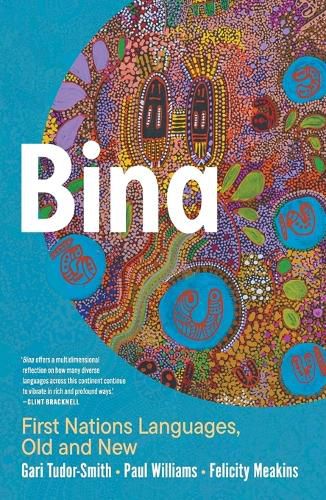Bina: First Nations languages, old and new by Gari Tudor-Smith, Paul Williams and Felicity Meakins

Designed as a book for general public, Bina enlightens readers about how Australian First Nations languages are integral to identity and culture, imbuing inherent values and sharing knowledge. An example is the word ‘bina’ itself, with meanings of ‘ear’, ‘know’, ‘listen’, ‘remember’. The reprimand ‘binang gunj’ translated literally as ‘earless’ means ‘You’re not paying attention’. It illuminates the aural nature of Aboriginal knowledge, in contrast to English which draws attention to the eye, as in ‘I see’ for ‘I understand’.
Another interesting observation is the lack of gendered pronouns in most Aboriginal languages; there is no gender distinction between she, he, it. Current speakers of English are discovering the dilemma of how to refer to transgender and non-binary people, with the use of ‘they’ (singular) becoming a mainstream convention. These fascinating kinds of distinctions reflect the values and customs embedded in language.
The book Bina explores the richness of our First Nations languages. That is no small feat as there are estimated to be over 440 unique languages and many more dialects. Traditionally Aboriginal people would be multilingual, speaking the languages of family, neighbours and other groups with which they had contact. New languages such as Pidgin, Creoles and Aboriginal English have evolved through contact with colonisers.
Most devastating has been the loss of numerous languages due to the impact of colonisation. For First Nations people, Country, culture and language are intertwined. 'Biriwalgal', the chapter on the arrival of the English, provides a concise account of the destruction of land, spread of disease, frontier warfare, massacres, relocation of traditional groups, 'stolen generations' and the ensuing loss of language. It is a terrible history.
The good news is the movement towards recovery and revitalisation of languages, with vocabulary and grammar being researched and recorded, First Nations languages taught in schools and tertiary institutions, and the variety of stories, music, art and performances bringing language to life. Anita Heiss’s books, Dirrayawadha (2024) and Bila Yarrudhanggalangdhuray (2021), incorporating Wiradyuri language, are an example, but there are many others.
For readers interested in languages, Bina provides fascinating examples of word meanings and concepts, common usage and grammar structure, and what that reveals about the culture of the speakers. For the general reader, a window is opened to the complexities of First Nations languages, the variety of languages spoken in Australia, and the toll that invasion has taken on the original inhabitants of this country. In this decade, the UNESCO International Decade of Indigenous Languages (2022-2032), it is timely to remember that language is a basic human right, and that all Indigenous peoples have the right to communicate in their first language. The extensive research undertaken for Bina provides the opportunity for each person to find out a little about the language of their local area, and the amazing wealth of language and culture to be found in Australia.
Themes: First Nations, Aboriginal languages, Aboriginal culture, Aboriginal history.
Helen Eddy